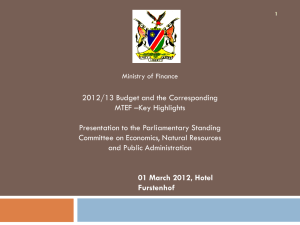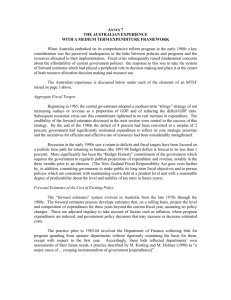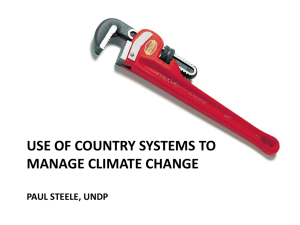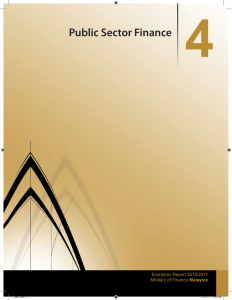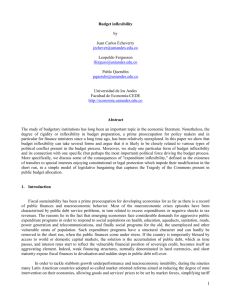Session 2_Thailand_Reungsri
advertisement
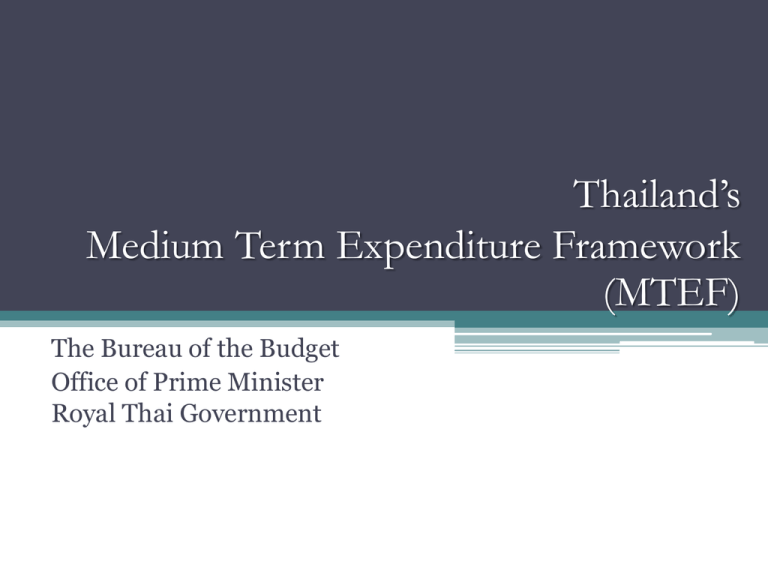
Thailand’s Medium Term Expenditure Framework (MTEF) The Bureau of the Budget Office of Prime Minister Royal Thai Government SPBBS : The Principle Policy aspects Management aspects • Top-down policy driven • Deconcentration • Strategic allocation • Good governance • Fiscal discipline • Financial disclosure • Effective budgeting • People oriented • Management flexibility Elements of SPBBS Result oriented Strategic Target Ministry Target Output and KPI Medium Term Expenditure Framework - MTEF Devolution Comprehensiveness Good Governance Monitoring and Evaluation Medium Term Expenditure Framework (MTEF) cover both top down and bottom up estimates: Macro fiscal projection – to establish budget ceiling based on resources (such as taxes, fiscal policy) and constraints (such as debt, and contingent liabilities), and stating all economic assumptions Micro baseline projection – to establish baseline expenditures based on existing policies at agency level Prudent Reconciliation process of top-down and bottom-up projections 5 MTEF Process (simplified) Macroeconomic forecasting Fiscal target Updated cost estimate of existing policy/program Total expenditure setting for multi-years New sectoral demand for t+3 (priority/cost) Sectoral ceiling setting for multi-years Annual budget formulation Sectoral Budget Preparation Fiscal Sustainability Results from the Processing Modules Assumptions Macro- Framework Expenditure & Revenue Endogenous Inputs Stock of Public Debt Fiscal Sustainability Assessments Macro Economic Assumption Indicators Real GDP growth (%pa) Inflation Rate growth (%pa) Import growth (%pa) Time deposit rate (%) Time deposit growth (%pa) Minimum loan rate (%) Loan on private sector (%pa) 2010 7.0 – 8.0 3.0 – 4.0 27.72 0.72 -9.78 5.93 6.70 2011 4.0 – 5.0 2.5 – 3.5 10.00 0.78 0.00 6.00 5.00 2012 4.0 – 5.0 2.5 – 3.5 10.00 0.78 0.00 6.00 5.00 Source : Bureau of the Budget, Bank of Thailand, NESDB 2013 4.0 – 5.0 2.5 – 3.5 10.00 0.78 0.00 6.00 5.00 2014 4.0 – 5.0 2.5 – 3.5 10.00 0.78 0.00 6.00 5.00 Bureau of The Budget’s strategy measurement Investment Tourism Remaining Budgets (Fiscal Space) To be accordance with human power improvement Minimum Investment Education Commitment Expenditure Personnal Expenditure Revolving Fund Local Authority Subsidy Government External Borrowing Project/Program Loan Loss from FIDF External Internal Borrowing Borrowing SOEs Public health The measurement of budget allocation is essential Fiscal Sustainability Framework Infrastructure Social network Fiscal Sustainability Framework Remaining Budgets Remaining Budgets Remaining Budgets Remaining Budgets การลงทุนขัน้ ต่า การลงทุนขัน้ ต่า การลงทุนเงิขันน้ เดื ต่าอน/ค่ าใช้ จ่ายบุคลากร Minimum Investment เงินเดือน/ค่ าใช้ จ่ายบุคลากร เงินเดือน/ค่ าใช้ จ่ายบุคลากร Personnel Expenditure เงินอุดหนุน เงินอุดหนุน เงินอุดหนุน กู้ใน Subsidy and Funds กู้ใน กู้ใน External Borrowing Internal Borrowing Public Debt / GDP < 60% Debt Service / Budget < 15% Balance Budget Key Figures Fiscal Year 2011 2012 Revenue Projection 2013 2014 Unit : Millions of Baht On Budget Basis 1,793,569 1,934,549 Expenditure Projection Expenditure 1.Current Expenditure (% of total) 1.1 Personal Exp. 1.2 Operating Exp. 1.3 Interest Payment 1.4 Commitment Exp. 1.5 Revolving Fund 1.6 Transfer and Subsidy 2. Capital Expenditure (% of total) 2.1 Subsidy Local Authority 2.2 Commitment Exp. 3.Principle Expenditure (% of total) Fiscal Space* 2,100,942 2,281,075 Unit : Millions of Baht 1,546,305 1,153,243 72% 502,658 189,292 118,171 31,823 146,506 164,793 236,905 15% 141,436 95,469 156,157 10% 247,264 1,383,839 1,170,260 66% 532,518 189,292 112,718 9,158 151,812 174,763 186,294 11% 158,820 27,473 27,285 2% 550,710 1,646,737 1,199,053 62% 564,169 189,292 101,378 3,023 156,816 184,375 183,729 9% 174,659 9,070 263,955 14% 454,205 1,640,168 1,219,469 57% 597,719 189,292 75,158 595 161,878 194,826 194,317 9% 192,531 1,786 226,382 11% 640,907 Revenue Module Direct Tax TAX PIT CIT PTT EXCISE Indirect Tax VAT Import Duty SBT Domestic Borrowings Estimation SOEs domestic debt Govt domestic debt Total domestic debt Domestic Borrowing Projection External Borrowings Sensitivity Analysis on Interest Rate and Exchange Rate Query Function External Borrowing Exchange Rate Converting External Borrowings สาขาเกษตรกรรม 50% ส าข าวิ ท ยาศ าส ต ร์ แล ะเทค โนสาข โล ยีาข น ส่ งทางบก สาขาพลั งงาน 50% 4 5 % ฒ น าชนสาขาขน บท ส่ งทางอากาศ สาขาสถ าบั น การเงิ น แล ะประกั น ภัสาขาพั ย 40% 5 0 % 40% 40% 50% 40% 30% 20% Data-base External Debt 50% 40% 10% 30% 30% 0% 10% ปี ที่ 1 0% 50% 30% 35% สาขาการศึ ะการฝึ กอบรม สาข4าการจั 0 % ด สรรทรั สาขาทีา้ ่ อ ยู่ อาศั ยแล ะการพั ฒ น าเมื อกษาแล ง 3 0 % พ ยากรน 30% 30% 30% 50% 25% 40% 20% 20% 25% 50% 30% 10% 40% 20% 40% 30% 50% 20% 30% 40% 10% 5% %2 0 % 130% 10%3 025% 0% 0% 10% 20% 50% 10% 0% ปี ที่ 3 1 0 % ปี ที่ 5 ปี ที่ 1 ปี ที่ 3 0% 10% 10% ปี ที่ 1 ปี ที่ 3 ปี ที่ 5 ปี ที่ 1ปี ที่ 7 20% 0% ปี ที่ 1 ปี ที่ 3 5% 22 300% % 0% 25% 20% 10% 15% 15% 15% 20% 10% % 10% 2205% 0% 0% 0% 0% 25%5 % 1 50% 20% % 0ปี%ที่ 5 0ปี%ที่ 7 0 ปี ที่ 3 0% 0%%ปี ที่ 9 0% 0% ปี ที่ 31 0 % ปี ที่ 5 ปี ที่ 7 ปี ที่ 5 ปี ที่ 7 ปี ที่ 9ปี ที่ 1 5% 10% 0% 0 % 0 % 0% 0% 0% 0% 0% ปี ที่ ปี3 ที่ 9 ปี ทีปี่ ที 1่ 5 ปี ทีปี่ ที 3่ 7 ปี ทีปี่ ที 5่ 9 ปี ที่ 7 ปี ที่ 9 0% 20% 0% 0% 20% 0% 10% 20% 10% 1 0 % 20% ่ 1 ปี ที่ 7 0% ปี ที่ ปี9ที0% 30% 25% 0% ปี ที่ 5 ปี ที่ 1 ปี ที่ 7 ปี ที่ 3ปี ที่ 9 ปีปี ที ที่ ่ 15 ปีปีทีที่ ่ 37 ปีปีทีที่ ่ 59 ปี ที่ 7 0% 0% ปี ที่ 9 0% ปี ที่ 9 Assume Disbursement Patterns : ADiPs 22 branch Disbursement Interest Payment Principle Payment Revolving Funds Health fund Student Loan Revolving Fund Universal Health Care Fiscal Year Budget Allocation for Health Care Policy 2011 2012 2013 2014 122,158 130,530 139,429 148,883 Deducted at Government Procurement 34,658 36,217 37,847 39,550 1) Expenditure on Salaries of government Officers, affiliated with the Ministry of Public Health 32,921 34,403 35,951 37,568 2) Expenditure on Salaries of government Officers, not affiliated with the Ministry of Public Health 1,679 1,754 1,833 1,916 118 123 128 134 87,500 94,313 101,582 109,332 3) Others ๆ Budget Allocation for Revolving fund for Health Care Funds Funds 2011 2012 2013 2014 1 Revolving Fund for Health Care 87,500.16 94,312.53 101,581.73 109,332.25 2 Student Loans Fund 25,407.45 23,901.14 21,636.60 18,947.89 0.00 0.00 0.00 0.00 2,499.10 2,499.10 2,499.10 2,499.10 615.00 615.00 615.00 615.00 6 Fund for Promotion of Social Security 30.00 30.00 30.00 30.00 7 Fund for National Sports Development 250.00 250.00 250.00 250.00 8 Fund for Revitalization of the Disabled 50.00 50.00 50.00 50.00 100.00 100.00 100.00 100.00 10 Land Readjustment Fund 60.00 60.00 60.00 60.00 11 Fund for Children Protection 60.00 60.00 60.00 60.00 for Restructuring of Agricultural 12 Fund Production to Improve Competitiveness 100.00 100.00 100.00 100.00 13 Fund for Political Party Development 200.00 200.00 200.00 200.00 14 Fund for Criminal Investigation 500.00 500.00 500.00 500.00 17,336.00 17,336.00 17,336.00 17,336.00 3 Income Contingent Loan Fund for Farmer Rehabilitation and 4 Fund Development for Small and Medium Enterprises 5 Fund Promotion 9 Fund for Senior Citizens 15 Other Funds Local Authorities Self Collected Subsidy from the Budget Government Collected Revenue Sharing Gov’t Revenue L/A Rev Previously 25.2% Local Authority Revenues Type of Revenues Revenue collected by Local Administrative Organization 2011 2012 2013 2014 39,833.59 43,360.15 47,201.05 51,384.32 148,484.76 157,725.38 167,779.16 178,717.68 Revenue sharing from government Taxes 80,982.21 93,526.31 107,442.80 122,892.69 Revenue from Subsidies and duties transfer 194,674.34 215,829.45 239,524.61 266,085.22 Total of Local revenues 463,974.89 510,441.29 561,947.61 619,079.92 Revenue from Local Taxes collected by Government Commitment Budget and outyears Personnel Expenditure Personnel Expenditure - Wage and Salary - Wage for temporally - Benefit for government employee 2011 2012 2013 2014 502,658 532,518 564,169 597,719 484,611 513,388 543,891 576,224 1,515 1,606 1,702 1,804 16,532 17,524 18,576 19,690 Lessons Learned 1. To forecast the outyear budget (year 2-4) need both unit cost and output: lacking of quantitative indicators make the output forecast a difficult task. 2. Understanding of government agencies 3. The rolling MTEF make the forecast less important. 4. Dependence on external economy 5. Political Stability
